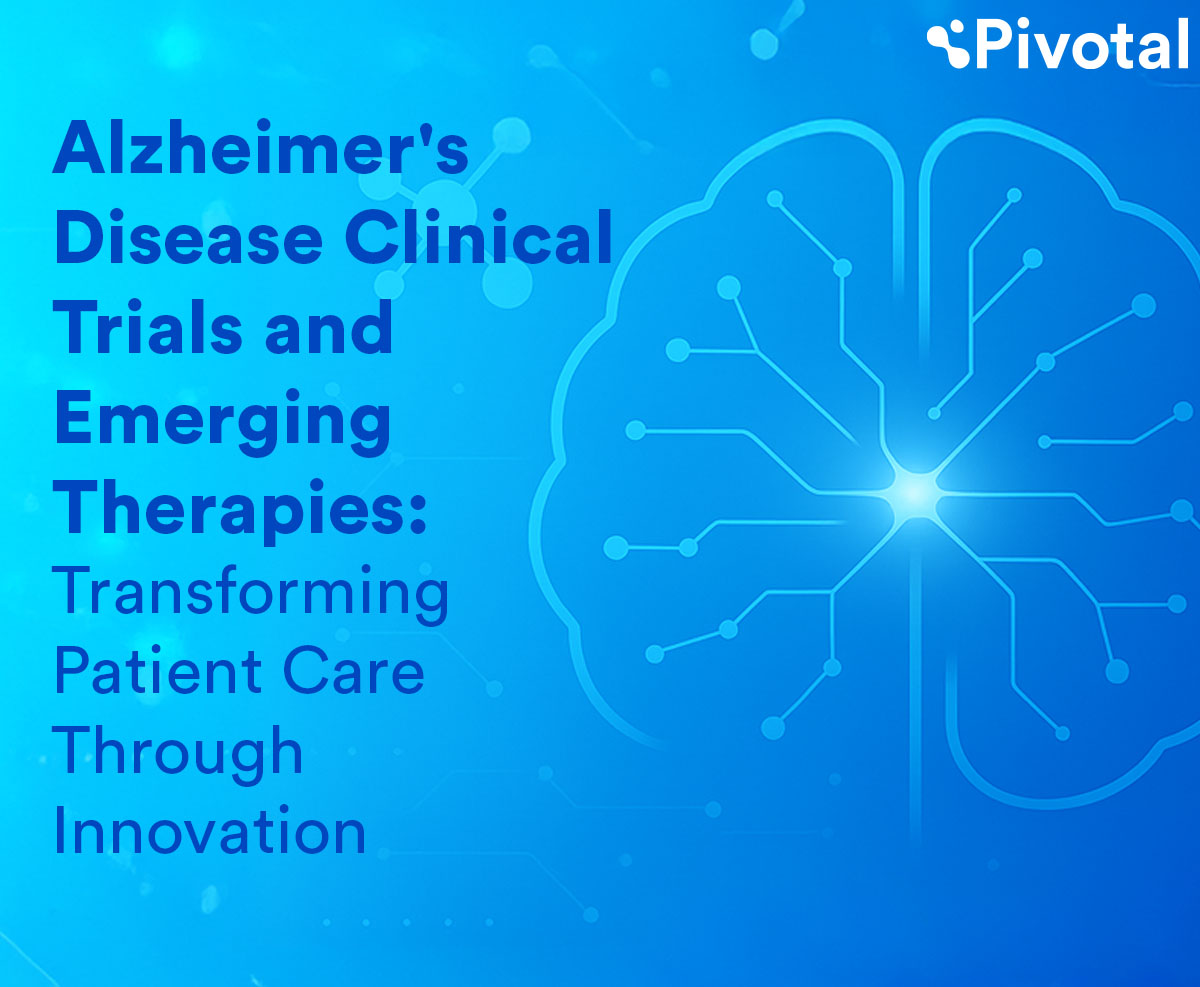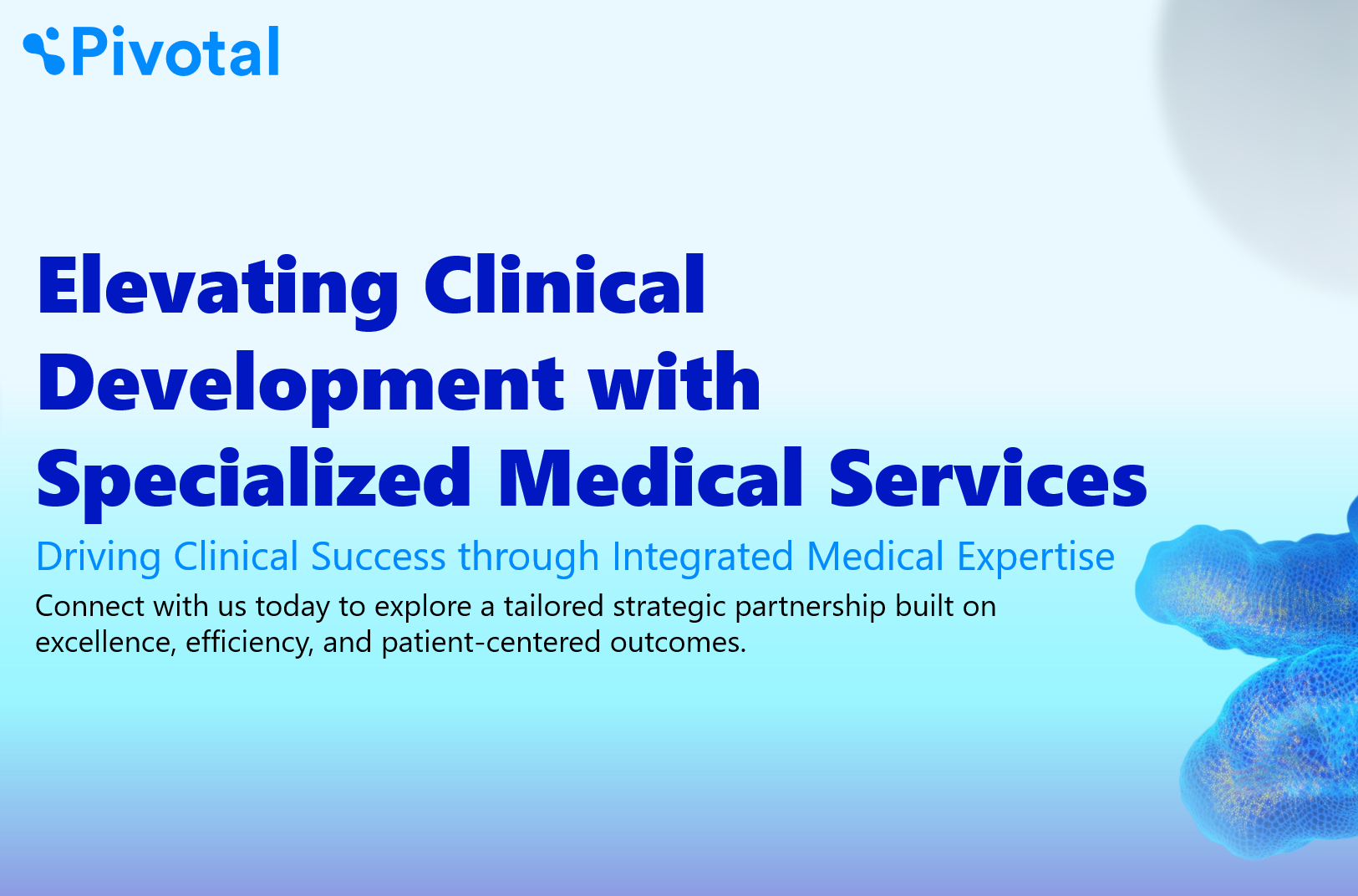Executive Summary
Alzheimer’s disease (AD) is one of the most significant and pressing challenges in modern healthcare. Affecting more than 50 million people worldwide1, AD places an immense and growing social and economic burden on societies as populations age. After decades of treatments that only addressed symptoms, the emergence of disease-modifying therapies (DMTs) has reshaped the therapeutic landscape, offering renewed hope for slowing or altering disease progression.
This white paper presents an updated, evidence-based overview of the evolving AD landscape, highlighting recent clinical and regulatory milestones, operational challenges in contemporary trials, and the ways specialized clinical research organizations (CROs), such as Pivotal, are advancing innovation through scientific and operational excellence.
The Evolving Paradigm of Alzheimer’s Disease: From Symptomatic Management to Disease Modification
Historically, AD was diagnosed primarily through clinical assessment, often confirmed only post-mortem. Early diagnostic frameworks such as the 1984 NINCDS-ADRDA criteria focused on cognitive and behavioral symptoms, which frequently delayed diagnosis until substantial neuronal loss had occurred2.
Recent research has redefined AD as a biologically measurable continuum. The 2024 revised NIA-AA criteria now define the disease by the simultaneous presence of both amyloid-beta (Aβ) and tau pathology, which allows for diagnosis at pre-symptomatic stages and supports preventive strategies3. This conceptual shift has fundamentally transformed the design of clinical trials and the selection of patients.
Breakthroughs in Disease-Modifying Therapies: The Amyloid Hypothesis and Clinical Validation
The amyloid cascade hypothesis continues to serve as the foundation for current DMTs. Monoclonal antibodies, such as Lecanemab and Donanemab, specifically target Aβ aggregates aiming to reduce plaque burden and slow cognitive decline4.
Regulatory Milestones in Europe
Lecanemab (Leqembi®): Initially deferred by the EMA’s CHMP in July 2024; a positive opinion was issued in November 20245, followed by final approval by the European Commission in April 20256.
Donanemab (Kisunla®): Initially rejected by the CHMP in March 2025 due to considerations of the benefit-risk ratio; a revised positive opinion was issued in July 20257 leading to the European Commission’s approval in September 20258. This approval is limited to ApoE4 heterozygotes and non-carriers, reflecting the need for risk stratification related to ARIA.
Efficacy Data from Pivotal Trials
Lecanemab (Clarity AD): This trial demonstrated a 27% reduction in the CDR-SB after 18 months of treatment (translating to a 0.45-point difference; p<0.001), alongside substantial amyloid clearance9.
Donanemab (TRAILBLAZER-ALZ 2): In early-stage patients it showed a 35% reduction on the iADRS resulting in a 2.92 point difference (p<0.001)10.
Although statistically significant, these corresponding effect sizes (Cohen’s d ≈ 0.21–0.23) are considered modest, and their clinical relevance, particularly regarding functional independence and quality of life, remains under active discussion11.
Safety and Monitoring
Amyloid-related imaging abnormalities (ARIA) continue to pose significant safety concerns in AD treatment:
- ARIA-E: Occurs in 12–24% of treated patients.
- ARIA-H: Affects 17–20% of patients.
- Symptomatic ARIA: Observed in 3–6% of patients, with rare serious outcomes specifically noted in individuals who are homozygous for the ApoE4 allele.
These risks underline the necessity for vigilant MRI monitoring and careful risk-based patient selection, both of which significantly influence trial design and operational complexity.
Operational Challenges in Modern Alzheimer’s Trials
1. Biomarkers-Driven Recruitment: AD trials now require confirmation of amyloid pathology, leading to an increase in screening failure rates (30–50%). While PET imaging remains the gold standard for this confirmation, it is both costly and limited in capacity. CSF biomarkers are a less invasive alternative, but they encounter significant patient refusal rates. However, plasma biomarkers such as p-tau217, have been robustly validated as feasible and cost-effective tools for detecting Alzheimer’s pathology. Large-scale studies have demonstrated their diagnostic accuracy, achieving high concordance with amyloid PET results in relevant clinical settings, thereby supporting their use for screening and monitoring12,13. Additionally, formal recommendations for their appropriate use now offer guidance on their integration into clinical trials and practice14.
2. Infrastructure Requirements: Trials must incorporate MRI, PET, CSF, and plasma biomarker pipelines, which require close collaboration among the different stakeholders: clinical sites, imaging vendors, and CROs.
3. Patient Retention: The high burden of clinical visits and infusion schedules necessitate patient-centric strategies. These can include eConsent, decentralized monitoring, and active community engagement.
Next-Generation Therapeutic Strategies
The development pipeline is expanding beyond amyloid-targeting to include interventions aimed at tau, neuroinflammation, and synaptic resilience. Tau aggregation inhibitors and anti-tau antibodies are progressing through Phase 2 and 3 development pathways15. Additionally, therapies targeting microglial regulation (such as, TREM2 agonists) represent a promising avenue of research16.
Prevention-focused trials, such as AHEAD 3–45, are investigating early interventions in cognitively normal individuals who have elevated amyloid burden17. Furthermore, precision approaches that integrate genetic profiling (APOE) with biomarker analysis are redefining how patients are stratified and how safety oversight is conducted.
Implementation and Readiness in Europe
A 2023 survey conducted by the European Academy of Neurology (EAN) identified critical and significant gaps in readiness for the rollout of DMT: More than 50% of the European neurologists who responded reported feeling unprepared to implement these treatments, citing, as major barriers, the limited access to biomarker diagnostics and MRI monitoring. Additionally, 93% of respondents expressed the need for training on managing ARIA18.
Pivotal’s Role: Bridging Science and Operations
Our Global CRO, Pivotal, combines medical expertise with operational excellence to accelerate AD trials. Our comprehensive approach includes, among others:
- Strategic Protocol Design: We develop scientifically robust and operationally feasible protocols, that incorporate biomarker strategies from the very beginning.
- Expert Regulatory Guidance: We provide end-to-end support navigating through complex European regulatory frameworks, leveraging our extensive deep experience with EMA and national bodies to ensure efficient submission and approval processes.
- Site optimization: Pivotal’s operational and medical team leverages a vetted network of experienced neurology centers to enhance trial site performance.
- Data-Driven Oversight & Risk Management: Using our proprietary Danah platform, Pivotal’s team conducts centralized monitoring and apply predictive analytics to enhance trial oversight.
- Patient engagement: We foster partnerships with patients advocacy groups (PAGs) and utilize digital tools to minimize participant burden and reduce dropout rates.
Shaping the Future of Alzheimer’s Research
Pivotal is leading the way in next-generation Alzheimer’s studies by facilitating:
- Advanced Therapeutic Strategies: We are prepared to support complex trials, that include combination therapies targeting amyloid, tau, and inflammatory pathways simultaneously, paving the way for more comprehensive treatment options.
- Equitable access initiatives: We are committed to ensuring representation across Europe and elsewhere, implementing strategies that promote equitable access to clinical trials and research participation for diverse populations.
Conclusion
The evolution of Alzheimer’s research signifies both a remarkable scientific achievement and an operational challenge. The modest clinical benefits of DMTs must be carefully weighed against considerations of real-world feasibility, cost, and safety. Success in this new era will depend on collaboration among all stakeholders, robust infrastructure, and specialized expertise.
Pivotal’s integrated model—combining board-certified neurologists, standardized imaging protocols, advanced data platforms, and solid site partnerships—positions us to lead this transformative journey. Whether we are advancing anti-amyloid programs, tau-targeted therapies, or prevention studies, Pivotal is committed to delivering the scientific rigor and operational precision that are essential for achieving success in Alzheimer’s Disease research and development of specific treatments.
References
- World Health Organization. Global Status Report on the Public Health Response to Dementia. Geneva: WHO; 2021.
- McKhann G, et al. Clinical diagnosis of Alzheimer’s disease: Report of the NINCDS-ADRDA Work Group. Neurology. 1984;34(7):939-944.
- Jack CR, et al. Revised criteria for diagnosis and staging of Alzheimer’s disease: Alzheimer’s Association Workgroup. Alzheimers Dement. 2024;20(1):542-558.
- Hardy J, Selkoe DJ. The amyloid hypothesis of Alzheimer’s disease: Progress and problems on the road to therapeutics. Science. 2002;297(5580):353-356.
- European Medicines Agency. Assessment report: Leqembi (lecanemab). EMA/CHMP/211479/2024. November 2024.
- European Commission. Commission Decision on the marketing authorization for Leqembi (lecanemab). April 15, 2025.
- European Medicines Agency. Assessment report: Kisunla (donanemab). EMA/CHMP/337284/2025. July 2025.
- European Commission. Commission Decision on the marketing authorization for Kisunla (donanemab). September 25, 2025.
- van Dyck CH, et al. Lecanemab in Early Alzheimer’s Disease. N Engl J Med. 2023;388(1):9-21.
- Sims JR, et al. Donanemab in Early Symptomatic Alzheimer’s Disease: The TRAILBLAZER-ALZ 2 Randomized Clinical Trial. N Engl J Med. 2023;389(18):1715-1726.
- Andrews JS, et al. Evaluating the Meaningfulness of Change in Alzheimer’s Disease Clinical Trials. Neurology. 2023.
- Plasma P-tau181 in Alzheimer’s disease: relationship to other biomarkers, differential diagnosis, neuropathology and longitudinal progression to Alzheimer’s dementia.
- Ashton NJ, et al. Diagnostic accuracy of a plasma phosphorylated tau 217 immunoassay for Alzheimer disease pathology. Nat Med. 2024;30(5):1445-1453.
- Hansson O, et al. The Alzheimer’s Association appropriate use recommendations for blood biomarkers in Alzheimer’s disease. Alzheimers Dement. 2024;20(1):1-14.
- Congdon EE, Sigurdsson EM. Tau-targeting therapies for Alzheimer disease. Nat Rev Neurol. 2018;14(7):399-415.
- Heneka MT, et al. Neuroinflammation in Alzheimer’s disease. Lancet Neurol. 2015;14(4):388-405.
- Sperling RA, et al. The A4 Study: Stopping AD Before Symptoms Begin? Sci Transl Med. 2014;6(228):228fs13.
- de Mendonça A, Apostolov LG, Scheltens P, et al. A Global Survey of Healthcare Professionals’ Perceptions on the Implementation of Disease-Modifying Treatments for Alzheimer’s Disease. Eur J Neurol. 2023;30(S1):5-632.
MEDIA CONTACT
Ms. Natalia Farr




